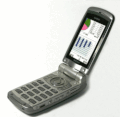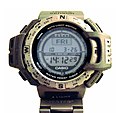Casio
- for CaSiO3 see calcium silicate
| File:Casiologo.png | |
| Company type | Public (Casio on TSE) |
|---|---|
| Industry | Electronics |
| Founded | Tokyo (1946) |
| Headquarters | Tokyo, Japan |
Key people | Kazuo Kashio, President |
| Revenue | ¥620,769 million (2007) |
Number of employees | 13,013 (2007) |
| Website | www.casio.com |
Casio Computer Co., Ltd. (カシオ計算機株式会社, Kashio Keisanki Kabushiki-gaisha) (TYO: 6952) is a Japanese electronic devices manufacturing company founded in 1946, with its headquarters in Tokyo. Casio is best known for its calculators, audio equipment, PDAs, cameras, musical instruments, and watches. In 1957 Casio released the world's first entirely electric compact calculator.
History

Casio was established in April 1946 by Tadao Kashio (樫尾 忠雄, Kashio Tadao), an engineer specializing in fabrication technology. Kashio's first major product was the yubiwa pipe, a finger ring that would hold a cigarette, allowing the wearer to smoke the cigarette down to its nub while also leaving the wearer's hands free. Japan was impoverished immediately following World War II so cigarettes were valuable, and the invention was a success.
After seeing the electric calculators at the first Business Show in Ginza, Tokyo in 1949, Kashio and his younger brothers used their profits from the yubiwa pipe to develop their own calculators. Most of the calculators at that time worked using gears and could be operated by hand using a crank or using a motor. Kashio had some knowledge of electronics, and set out to make a calculator using solenoids. The desk-sized calculator was finished in 1954 and was Japan's first electro-mechanical calculator. One of the central innovations of the calculator was its adoption of the 10-key number pad; at that time other calculators were using a "full keypad", which meant that each place in the number (1s, 10s, 100s, etc...) had nine keys. Another innovation was the use of a single display window instead of the three display windows (one for each argument and one for the answer) used in other calculators.
In 1957 Casio released the Model 14-A, sold for 485,000 yen,[1] the world's first all-electric compact calculator, which was based on relay technology. 1957 also marked the establishment of Casio Computer Co. Ltd.
In the 1980s, its budget electronic instruments and home keyboards gained huge popularity. The company also became well known for the wide variety and innovation of its wrist watches. It is one of the early manufacturers of quartz-crystal watches, both digital and analog. It also began selling calculator watches during this time. It was one of the first manufacturers of watches that could display the time in many different time zones and of watches with temperature, atmospheric-pressure, and altitude displays.
Especially popular are its dual function (LCD and analog) watches, some of which, called Wave Ceptors, receive radio signals daily from an atomic clock to keep accurate time. These watches come with lengthy manuals(50 pages each in English and Spanish, each the size of a business card): those users who master all the intricate features will be able to tell time in many time zones, use alarms and timers, and even follow Daylight-Saving Time; those who ignore or misunderstand the manual can expect many surprises.
A number a notable digital cameras firsts have been made by Casio, including the first consumer digital camera with an LCD screen, the first consumer 3 megapixel camera, the first true ultra-compact model, and the first digital camera to incorporate ceramic lens technology.
Timeline of important product releases
- 1957 Casio releases the Model 14-A, the world's first all electric compact calculator
- 1965 The 001 calculator is released
- 1972 The release of Casio's personal calculator, the Casio "Mini" sells for 12,800 yen, going on to sell over 10 million units
- 1974 The Casiotron, a watch that features a fully automatic calendar, including month lengths and leap years, is released.
- 1980 Casio releases their Casiotone keyboard instrument.
- 1983 The first G-Shock watch, the DW-5000C, is released.
- 1985 Casio launches its first professional synthesiser, the CZ-101.
- 1995 The Illuminator/Foxfire backlight is released. The DW-5600E was announced as the first G-Shock watch with a full EL LCD panel.
- 1995 The QV-10, the world's first digital camera that includes a TFT display, is released.
- 2002 The EX-S1, the first Exilim digital camera is released.
- 2007 The OCW-S1000J, dubbed the Oceanus "Manta", is released being the world's thinest solar-powered chronograph being only approx. 8.9mm in thickness.
Products
- Calculator
- Cash register
- Illuminator (backlight)
- Digital camera - Exilim Series
- Laptop and Sub-notebook computers
- Mobile phone
- Electric keyboard (musical instrument)
- PDA and E-Data Bank
- Electronic dictionary and Wordtank
- Digital Diary
- Computer printer
- Clock, Quartz clock, and Watch
- Portable Television and Handheld television
-
An old Casio Calculator
-
QV-10 Digital camera
-
EX-S600 Digital Camera
-
Au W31CA Mobile phone
-
DW5600C A G-Shock watch
-
DW-5600E-1V One of the first Illuminator watches
-
Casio PRG 60 AVER Triple Sensor Watch
-
Casio "Wave Ceptor" Radio-Synchronized Watch
-
Pro Trek Triple Sensor Watch
-
Casio Desk Clock
Miscellaneous
- A Casio digital watch was used as the timer for the bomb used in the Oplan Bojinka plot.
- In the film, The Cat in the Hat, the main character, the Cat, plays a piano with the logo "Cat-sio" printed on it, an obvious spoof of the company's name.
- In the videogame Headhunter, by Amuze and Sega for the Dreamcast and Playstation 2, the protagonist of the game, Jack Wade, has a fictional wrist watch VM, which is based on a real-life Casio wrist watch, the WQV-2. The WQV-2 has a built-in digital camera, while the fictional version seen in the game had many additional functions, like a built-in location tracker and a cell phone.
References
- ^ Casio desktop calculator by Dentaku Museum.
See also
- Casio F91W watch
- Casio DW-5600C watch
- Casio DW-5600E watch
- Casio DH-100 electronic saxophone
- Casio Cassiopeia PDA
- Illuminator (backlight) EL backlight
- Pocket viewer PDA
Synthesizers
- Casio CZ synthesizers
- Casio SD Synthesizers
- Casiotone synthesizers
Digital Cameras
Watch Series
Handheld computers
External links
- Casio Worldwide
- Yahoo! - Casio, Inc. Company Profile
- 2005 Annual report (PDF)
- Casio Kingdom The Casio calculator resource site
- Casio watches collection Casio watch collection
- Casio Watches One Stop Shop the World over









